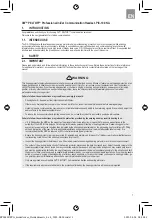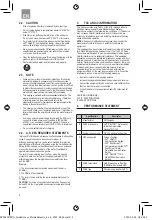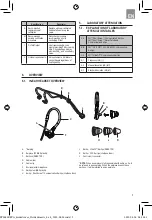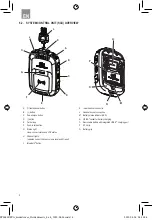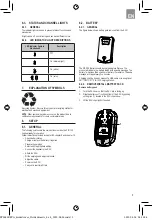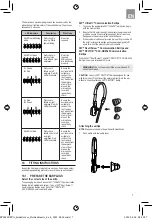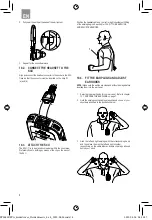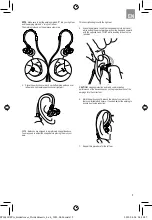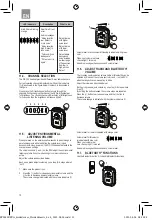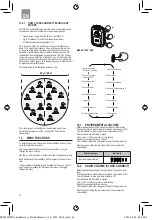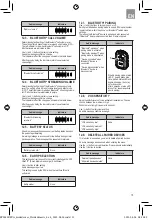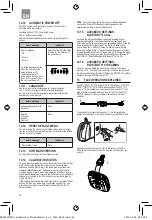
2
2.2. CAUTION
• Risk of explosion if battery is replaced by incorrect type.
• Do not charge battery in temperatures above 30°C/86°F or
below 10°C/50°F.
•
With lithium ion batteries, there is a risk of fire and burns.
Do not open, crush, heat above 50°C/122°F, or incinerate.
•
For greater comfort and safety when using the three-flange
3M™ UltraFit™ Communication Eartips, remove the eartip
slowly with twisting motion to gradually break the seal.
•
Always use product-specific 3M replacement parts. Use of
unauthorized replacement parts may reduce the protection
you receive from this product.
• Obey the instructions given in this manual. Tampering with the
product might void the IP54-approval of this product.
• Dust protected and water resistant when worn properly.
2.3. NOTE
• When worn according to these User instructions, this hearing
protector helps reduce exposure to both continuous noises,
such as industrial noises and noises from vehicles and aircraft,
as well as very loud impulse noises, such as gunfire. It is difficult
to predict the required and/or actual hearing protection obtained
during exposure to impulse noises. To learn more about hearing
protection for impulse noise, visit www.3M.com/hearing.
• This earplug is provided with level-dependent attenuation. The
wearer should check correct operation before use. If distortion
or failure is detected, the wearer should refer to the
manufacturer’s advice for maintenance and replacement of the
battery in the control unit (SCU).
• This earplug is provided with safety related audio input. The
user should check correct operation before use. If distortion or
failure is detected, the user should refer to the manufacturer’s
advice.
• If using an external power supply for charging the SCU, only
connect to a listed power supply certified to IEC/UL/CSA
62368-1 or an equivalent local safety standard. The power
supply shall have a rated output of 5 VDC, 500 mA (minimum).
• Do not use a splitter cable for charging.
2.4. U.S. EPA REQUIRED STATEMENTS
Improper fit of this device will reduce its effectiveness in attenuating
noise. Consult the enclosed instructions for proper fit.
Although hearing protectors can be recommended for protection
against the harmful effects of
impulsive
noise, the Noise Reduction
Rating (NRR) is based on the attenuation of
continuous
noise and
may not be an accurate indicator of the protection attainable
against
impulsive
noise such as gunfire.
The level of noise entering a person’s ear, when the hearing
protector is worn as directed, is closely approximated by the
difference between the A-weighted environmental noise level
and the NRR.
Example:
1. The environmental noise level as measured at the ear is
92 dB(A).
2. The NRR is 21 decibels (dB).
3. The level of noise entering the ear is approximately equal to
71 dB(A).
CAUTION:
For noise environments dominated by frequencies
below 500 Hz the C-weighted environmental noise level should
be used.
3.
FCC AND IC INFORMATION
This device complies with Part 15 of the FCC rules and Industry
Canada’s license-exempt Radio Standards Specifications.
Operation is subject to the following two conditions: (1) This device
may not cause harmful interference, and (2) this device must
accept any interference received, including interference that may
cause undesirable operation.
NOTE:
Changes or modifications not expressly approved by the
manufacturer could void the user’s authority to operate the
equipment.
This equipment has been tested and found to comply with the limits
for a Class B digital device, pursuant to part 15 of the FCC Rules.
These limits are designed to provide reasonable protection against
harmful interference in a residential installation. This equipment
generates, uses and can radiate radio frequency energy and, if not
installed and used in accordance with the instructions, may cause
harmful interference to radio communications. However, there is no
guarantee that interference will not occur in a particular installation.
If this equipment does cause harmful interference to radio or
television reception, which can be determined by turning the
equipment off and on, the user is encouraged to try to correct the
interference by one or more of the following measures:
• Reorient or relocate the receiving antenna.
• Increase the separation between the equipment and receiver.
• Connect the equipment into an outlet on a circuit different from
that to which the receiver is connected.
• Consult the dealer or an experienced radio/TV technician for
help.
CAN ICES-3 (B)/NMB-3(B)
FCC ID: DGFPSDPIC100NA
IC: 458A-PSDPIC100NA
4.
PERFORMANCE STATEMENT
Specification
Descriptor
A
Manufacturer
3M Company.
B
FAES brand name
3M™ PELTOR™ Professional
In-Ear Communication
Headset, PIC-100.
C
System requirements
PIC-100 headset and eartips.
D
HPDs supported
3 sizes of eartips:
• 3M™ UltraFit™
Communication Eartips,
• 3M™ Skull Screw™
Communication Eartips/3M™
Skull Screw™ Metal
Detectable Communication
Eartips
• 3M™ PELTOR™ CCC-
GRM-25 Communication
Eartips.
E
FAES test method
Field-Microphone in Real Ear
(F-MIRE) with standard HPD.
F
FAES type
Physical using standard HPD.
EN
FP3881REVA_6sidedcover_32sidedinserts_4 x 6_2022-08-24.indd 2
FP3881REVA_6sidedcover_32sidedinserts_4 x 6_2022-08-24.indd 2
2022-08-24 08:30:25
2022-08-24 08:30:25



